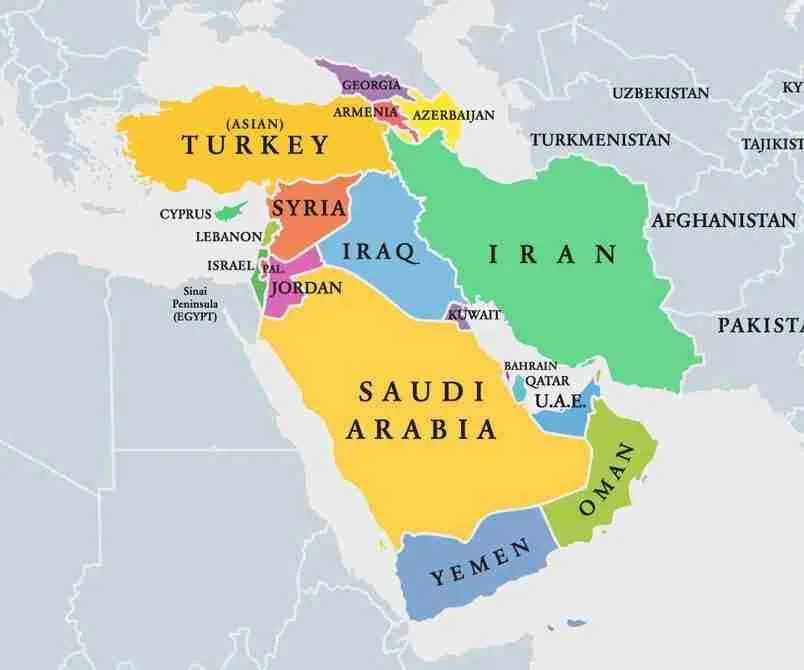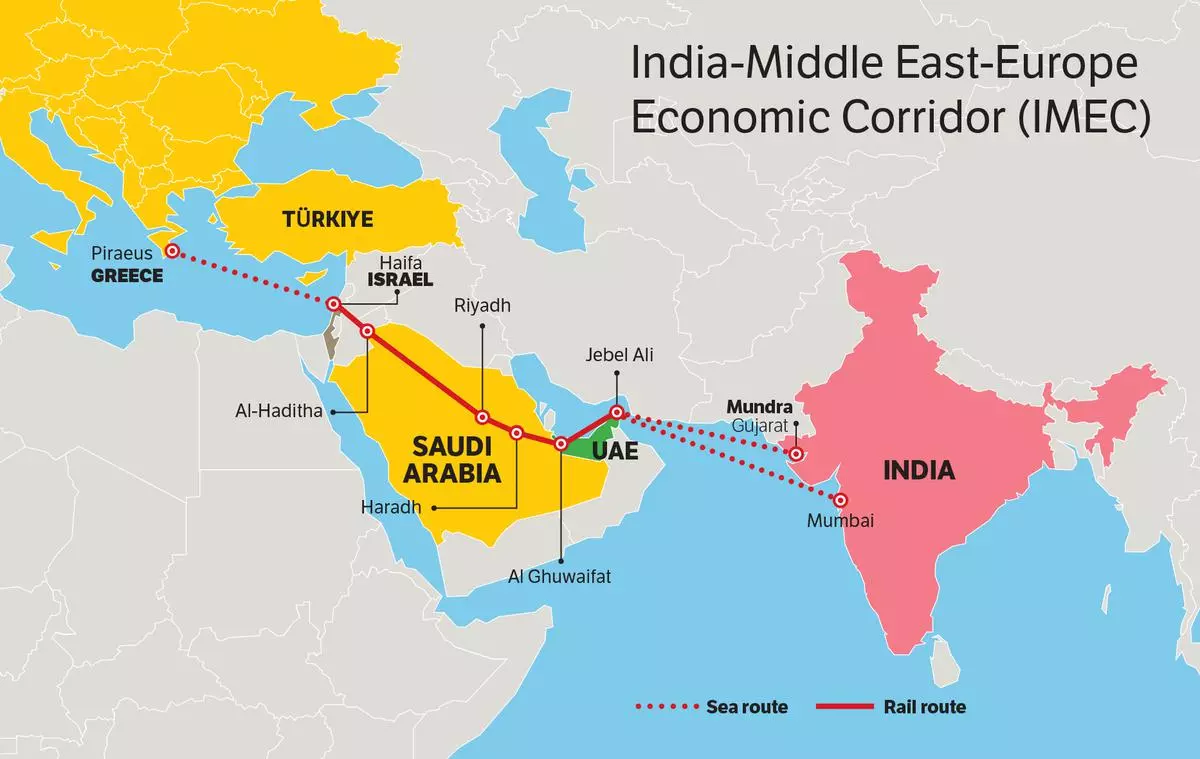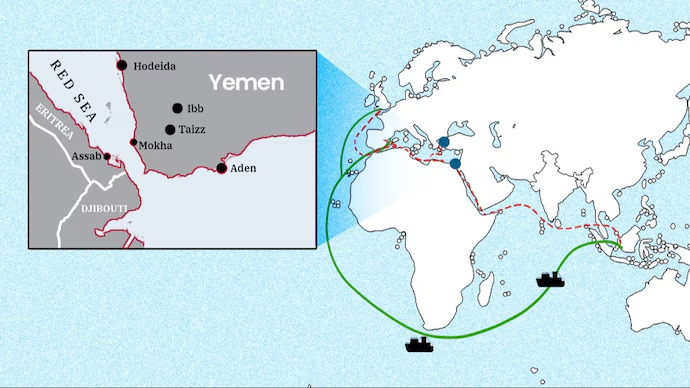International Relations
India's Renewed Focus on West Asia
- 07 May 2025
- 19 min read
This editorial is based on “Link West marks India’s strategic pivot in West Asia” which was published in Hindustan Times on 06/05/2025. The article brings into picture the transformation of India’s West Asia engagement from peripheral to strategic through the "Link West" policy, marked by key partnerships and initiatives like IMEEC, Chabahar Port, and defense ties.
For Prelims: West Asian region, Chabahar Port, Gulf Cooperation Council , Comprehensive Economic Partnership Agreements, Belt and Road Initiative,Organization of Islamic Cooperation, IMEC corridor, Non-Aligned Movement , Red Sea, Bab el-Mandeb Strait.
For Mains: India’s Relation with West Asian Countries, Issues Related to West Asia involving India’s interest.
India has transformed India's West Asia engagement from peripheral involvement to strategic influence through the pragmatic "Link West" outlook. This diplomatic pivot is anchored in robust partnerships with the UAE and Saudi Arabia, with bilateral trade reaching $84 billion and $43 billion respectively in 2023-24. India's strategic initiatives include the IMEC corridor connecting India to Europe via the Gulf, deepened defense cooperation with Israel, and development of Iran's Chabahar Port through the INSTC. The approach balances energy security, diaspora interests, and regional connectivity while navigating complex geopolitical tensions.
How have India’s Relations with West Asia Evolved over Time?
- Pre-Independence Era: Early Trade and Cultural Exchange
- India’s relationship with West Asia dates back to ancient times, driven by trade and cultural exchanges.
- Key trade routes linked India with the Arabian Peninsula, Persia, and beyond, facilitating the exchange of goods, ideas, and religious influences.
- Post-Independence (1947-1990s): Diplomacy with Non-Aligned Neutrality
- After independence, India's ties with West Asia were influenced by its Non-Aligned Movement (NAM) stance.
- While maintaining neutral relations with countries like Saudi Arabia, Iraq, and Iran, India also supported the Palestinian cause.
- The 1970s and 1980s saw India maintain strong relations with oil-rich nations, but economic engagement was limited to energy imports and labor migration.
- Liberalization and Economic Growth (1991-2000s): Expanding Economic Ties
- In the 1990s, India’s economic liberalization opened new doors for stronger commercial and diplomatic ties with West Asia.
- The Gulf region became critical for India’s energy security and remittances.
- India’s growing IT sector also began attracting interest from the Gulf states, strengthening economic ties.
- In the 1990s, India’s economic liberalization opened new doors for stronger commercial and diplomatic ties with West Asia.
- Strategic Reorientation (2000s-Present): Strengthening Strategic and Security Cooperation
- India pursued a more proactive foreign policy, leading to enhanced security and defense ties, particularly with Saudi Arabia, the UAE, and Israel.
- The region became a key partner in energy diversification, technology exchanges, and defense collaborations.
- New initiatives, like the I2U2 (India, Israel, UAE, US) and IMEC (India-Middle East-Europe Economic Corridor), underscore India’s increasing integration into regional geopolitical frameworks.
- Current Dynamics: Regional Leadership and Partnership
- Today, India’s relations with West Asia are marked by strategic partnerships, co-development projects, and a shared vision for sustainable growth.
- India's "Look West" outlook focuses on enhancing multidimensional engagement, prioritizing economic cooperation, security collaboration, and cultural exchanges.
- Today, India’s relations with West Asia are marked by strategic partnerships, co-development projects, and a shared vision for sustainable growth.
What is the Significance of West Asia for India?
- Economic and Trade Partnerships: India's economic engagement with West Asia is vital, driven by trade in hydrocarbons, infrastructure projects, and emerging sectors like renewable energy.
- As India’s fifth-largest economy, the region supplies critical energy resources while offering lucrative investment opportunities.
- The UAE, India's third-largest trading partner, shared $84 billion in trade in 2023-24, illustrating the region's economic importance.
- The India-UAE Comprehensive Economic Partnership Agreement (CEPA) targets $100 billion in non-oil trade by 2030.
- Additionally, the Gulf Cooperation Council region accounts for 15.8% of India's total trade in 2022-23, emphasizing the interdependence between both regions.
- Energy Security: West Asia remains a cornerstone of India’s energy security, particularly in the oil and gas sectors, which fuel India’s growing industrial demands.
- Despite diversification, over 50% of India's crude oil imports still come from the Gulf.
- Saudi Arabia and Iraq are India’s top oil suppliers. India’s energy diversification efforts have been bolstered by partnerships like the 20-year LNG deal signed with Qatar in February 2024, which provides 38% of India’s LNG imports.
- Geopolitical and Strategic Importance: The Middle East is crucial for India’s broader geopolitical strategy, serving as a gateway to Europe, Africa, and Central Asia.
- India's deepening ties with key regional powers like Saudi Arabia and Israel, alongside a growing defense and security cooperation, solidify its regional influence.
- India’s participation in initiatives like the I2U2 (India, Israel, UAE, US) reflects the region's growing role in India’s strategic calculus.
- Furthermore, the India-Middle East-Europe Economic Corridor is a game-changing project to enhance connectivity through the Gulf.
- Security and Defense Cooperation: West Asia is pivotal for India’s security interests, particularly with regard to maritime security in the Arabian Sea and the Indian Ocean Region (IOR).
- Increasing missile and drone threats from Yemen’s Houthi rebels highlight the region's security vulnerabilities (as seen in the Red Sea Crisis recently).
- India’s expanded naval cooperation with countries like Oman, Saudi Arabia, and the UAE ensures regional stability, especially in securing vital trade routes.
- In 2023, trilateral maritime exercises involving India, the UAE, and France marked a significant step in regional defense collaboration.
- People-to-People and Diaspora Ties: As India’s External Affairs Minister rightly quoted that “our presence in the Gulf is both pervasive and crucial. More than 9 million Indians live and work here, and gulf also serves as a gateway to the MENA region and the Mediterranean”.
- The 9 million-strong Indian expatriate community sends home vital remittances, amounting to billions annually, strengthening bilateral ties.
- The UAE alone hosts over 3.5 million Indians, contributing significantly to the country’s labor force and economic development.
- The 9 million-strong Indian expatriate community sends home vital remittances, amounting to billions annually, strengthening bilateral ties.
What are the Key Challenges Affecting Effective India–West Asian Ties?
- Geopolitical Instability and Shifting Alliances: West Asia's geopolitical volatility, marked by conflicts like Israel-Hamas and the Saudi-Iran tensions, complicates India's diplomatic efforts.
- While India seeks a balanced approach, recent shifts like the Saudi-Iran détente brokered by China challenge its neutrality.
- India's interests with both nations, such as energy cooperation with Saudi Arabia and Chabahar Port access with Iran, are tightly interwoven.
- Energy Transition and Diversification of Sources: India's push for renewable energy creates tensions with its ongoing reliance on West Asian hydrocarbons, which still supply over 50% of its crude oil.
- While India continues to engage with the Gulf states for energy needs, the transition to green energy complicates long-term relations.
- India must navigate this dual challenge of energy security and green energy ambitions without destabilizing key partnerships in the Gulf.
- While India continues to engage with the Gulf states for energy needs, the transition to green energy complicates long-term relations.
- Competition from Global Powers and Strategic Alliances: China’s Belt and Road Initiative (BRI) has deepened its economic footprint in West Asia, challenging India’s influence in infrastructure and trade.
- While India’s economic ties with the UAE and Saudi Arabia have strengthened, China’s dominance in the other region complicates India’s goals.
- In 2023, China’s trade with Saudi Arabia exceeded $100 billion, further expanding its economic presence.
- India has responded by leveraging initiatives like the India-Middle East-Europe Economic Corridor (IMEC), but the competition for influence, especially in ports and infrastructure,that includes Gwadar Port (Pakistan), Port of Djibouti (Djibouti), Port of Aqaba (Jordan), and the proposed Iran-China trade corridor.
- Security Threats and Maritime Challenges: Increasing missile and drone attacks from Houthi rebels in the Red Sea complicate India’s maritime security efforts, impacting vital trade routes.
- The ongoing West Asian conflicts is expected to raise logistics and insurance costs, hurting India's trade in sectors like oil, electronics, and agriculture.
- The Bab el-Mandeb Strait and other choke points remain critical to India’s energy imports and trade, necessitating continued defense engagement.
- Diplomatic Balancing in a Multipolar Region: India faces the challenge of balancing its deepening ties with Israel and Gulf Arab nations while upholding its traditional support for Palestine.
- Though, India has leveraged its relationships with both Israel and the UAE in areas like defense, cybersecurity, and renewable energy, demonstrating its diplomatic agility. However, balancing these relationships with India’s long-standing support for Palestinian statehood remains a tightrope walk.
- Labor Rights and Migrant Issues: With over 9 million Indians working in the Gulf, ensuring migrant welfare remains a pressing concern in India-West Asia ties.
- Despite recent improvements, such as the UAE’s adoption of the RuPay card to facilitate financial integration, labor rights issues continue to strain relations.
- The recent fire tragedy in Kuwait, which claimed the lives of several Indian migrant workers, has brought renewed attention to the critical issue of their safety and well-being.
What Measures can India Adopt to Strengthen its West Asian Outlook?
- Deepening Multilateral Diplomatic Engagement: India should bolster its diplomatic footprint in regional multilateral frameworks, such as the India-Gulf Cooperation Council (GCC) Strategic Dialogue and I2U2 (India, Israel, UAE, US) partnerships.
- These platforms allow India to foster multilateral cooperation in regional security, economic development, and technological innovation.
- By engaging in regular dialogues on strategic issues like maritime security, climate resilience, and energy transition, India can emerge as a reliable partner in West Asia’s evolving geopolitical landscape.
- Expanding Economic and Trade Partnerships: India must strengthen its bilateral trade agreements with key Gulf nations, targeting sectors beyond traditional hydrocarbons, including renewable energy, information technology, and healthcare innovation.
- By fostering co-development initiatives in infrastructure, smart cities, and manufacturing, India can drive sustainable economic growth and create long-term interdependencies.
- A holistic approach to economic cooperation, underpinned by strategic commercial diplomacy, will solidify India’s position as a central economic partner for West Asia.
- Strengthening Security and Counterterrorism Cooperation: India should intensify security collaboration with Gulf nations through joint counterterrorism operations, intelligence-sharing platforms, and strategic defense partnerships.
- By creating regional security frameworks that prioritize collective defense and cybersecurity, India can enhance regional peace and security while safeguarding critical maritime routes.
- Strengthening counterterrorism mechanisms and border security initiatives will ensure that India and its West Asian partners collectively address growing threats from extremism.
- Operation Sindoor underscores India’s resolute commitment and capability to combat the menace of terrorism with precision and strategic resolve.
- Promoting People-to-People and Cultural Diplomacy: India must leverage soft power diplomacy by enhancing people-to-people connections through cultural exchanges, educational partnerships, and labor welfare programs.
- Strengthening the Indian diaspora's role in West Asia will deepen socio-cultural bonds and build a foundation of trust and shared values.
- By facilitating educational exchange programs, collaborative research initiatives, and cultural diplomacy, India can establish itself as a leader in human capital development.
- Fostering Strategic Regional Infrastructure Projects: India should spearhead infrastructure co-development projects across West Asia, focusing on connectivity corridors and port development.
- Initiatives like the India-Middle East-Europe Economic Corridor (IMEEC) will be instrumental in enhancing regional trade integration and fostering multimodal connectivity.
- By prioritizing cross-border infrastructure and sustainable development, India can foster economic interdependence and strategic regional integration.
- This will not only boost trade and investment but also serve as a catalyst for regional cooperation and geopolitical stability in the long term.
- Leveraging Digital and Technological Cooperation: India must intensify its digital diplomacy by promoting cybersecurity collaboration, digital financial inclusion, and AI-driven partnerships with West Asia.
- By offering technology transfer and establishing joint innovation hubs, India can support the region’s digital transformation and smart governance initiatives.
- Fostering technology incubators and entrepreneurship partnerships in sectors like FinTech, blockchain, and AI will enable both India and West Asia to co-develop future-proof economies.
Conclusion:
India’s West Asia outreach has matured into a future-ready strategic engagement—anchored in energy security, economic diversification, and regional connectivity. The growing synergy in trade, technology, and defense highlights India’s evolution from a passive partner to a proactive regional stakeholder. Going forward, India must sustain this momentum through inclusive diplomacy, infrastructural leadership, and people-centric partnerships.
|
Drishti Mains Question: "India’s engagement with West Asia has evolved from peripheral involvement to a strategic partnership, underpinned by economic, energy, and geopolitical considerations. Examine |
UPSC Civil Services Examination, Previous Year Question (PYQ)
Prelims
Q. Which one of the following countries of South-West Asia does not open out to the Mediterranean Sea? (2015)
(a) Syria
(b) Jordan
(c) Lebanon
(d) Israel
Ans: B
Q. The term “two-state solution” is sometimes mentioned in the news in the context of the affairs of (2018)
(a) China
(b) Israel
(c) Iraq
(d) Yemen
Ans: B
Mains
Q. “India’s relations with Israel have, of late, acquired a depth and diversity, which cannot be rolled back.” Discuss. (2018)










